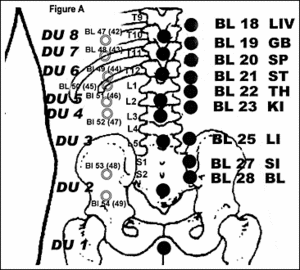Besides the common cold, more people worldwide, and in particular, people in contemporary Western nations, seek a doctor's care for lower back pain than the combined total of all other health conditions.
A review of these points, and utilization of just a few of the ones shown, will elicit incredible clinical response for low back pain in the majority of cases. There are additional points which are legendary for low back pain that are not found directly in the lumbar region. However, to the veteran practitioner, as well as the uninitiated, the local points illustrated here can and do illicit impressive response when stimulated by a variety of physiotherapeutic means or acupuncture needles.
Figure A is one that you will definitely want to clip and save for further review. The information here is way too important to do otherwise. Virtually every point illustrated will have a specific effect on lumbalgia. BL 23, BL 25, BL 27, BL 28, BL 52 (47), and Du (GV) 2, 3, 4, and 5 are well-known for their success in treating low back pain.
 The "Du" meridian, otherwise known as the Governing Vessel (GV), is a midline spinal meridian running from the perineum over the spinous processes, coursing over the head and ending just under the upper lip between the front two teeth. On this meridian, we find some of the most powerful acupuncture points on the body for treating a variety of conditions, other than the obvious low back pain:
The "Du" meridian, otherwise known as the Governing Vessel (GV), is a midline spinal meridian running from the perineum over the spinous processes, coursing over the head and ending just under the upper lip between the front two teeth. On this meridian, we find some of the most powerful acupuncture points on the body for treating a variety of conditions, other than the obvious low back pain:
- Du 2 - Expels interior wind, strengthens the low back and calms spasms and convulsions.
- Du 3 - Below the fourth lumbar; tonifies yang, and strengthens the lower back and legs.
- Du 4 - "Gate of Life" below the spinous of the second lumbar; nourishes the original chi, tonifies kidney yang, known as the Ming Men, "Gate of Vitality," and strengthens the lower back.
- Du 5 - Below the first lumbar spinous; for pain and stiffness of the low back, diarrhea and indigestion.
- Du 6 - Below the 11th spinous, historic area of chiropractic application according to Palmer.
- Du 7 - Below the 10th thoracic spinous; for epigastric pain, pain and stiffness of lumbar spine.
- Du 8 - Below the ninth thoracic spinous; expels interior Wind and relaxes tendons, sinews.
All of the acupuncture points beginning with BL 18 and progressing thru BL 28 are 1.5 tsun, or two fingerbreadths bilateral to the midline corresponding to the Du (GV) meridian. Each of these points is named after its specific association, thus "associated" (shu) points. The names of the associations are by abbreviation; the neophyte will just need to use a slight bit of imagination to understand their significance. BL 19, between T10 and T11, is associated with the GB or Gallbladder. Knowledge of the working mechanism of the Gallbladder meridian from an acu-practic standpoint will open up an entirely new world of healing. BL 19 specifically relaxes the diaphragm; therefore, it is used for chronic hiccough or anytime the diaphragm is involved. It also is known to pacify the stomach. For example, the Liver associated point BL 18, between T9-T10, has a very strong significance on the eyes as well as on the muscles, tendons and ligaments. This point moves stagnant chi in addition to resolving damp heat and expelling wind.
The two points known as BL 20 and BL 21, specifically associated with the Spleen and Stomach, respectively, are classic points to resolve musculoskeletal conditions as a result of dampness. They are located opposite of the lower spinous of the 11th and 12th thoracic vertebrae. This is an historic area of the body, as it, along with Du 6 and Du 7, is the area D.D. Palmer referred to as "Kidney." This area was adjusted in every condition, regardless of the diagnosis. It corresponds to the "Earth" element in acupuncture and is an area of extreme significance. I can be so bold as to say that every DC should consider some type of stimulus action on this area of points, on every patient who visits the office for care.
The point known as BL 22, or associated point to the Triple Heater (San Jiao) meridian, is a classic healing point. It is located two fingerbreadths opposite of the lower border of the spinous of the first lumbar. This point, along with BL 25 (Large Intestine) and BL 27 (Small Intestine), will have startling effects on gastrointestinal dysfunction, including colitis, diverticulosis, Crohn's disease, etc.
The Kidney associated point, namely BL 23, just opposite the lower spinous of L2, is one of the most known points on the body. It affects the entire Kidney network, including bone, marrow, ears and Kidney essence. It has a very strong effect on lumbar pain, tinnitus, dizziness, deafness, edema and asthma. It is a very significant point. The last associated point is BL 28, opposite the second sacral foramen. It is extremely significant for regulating the bladder, opening water passages affected by the lower burner of the Triple Heater. It strengthens the back and knee and has a strong effect on pain in general. It has a close interrelationship with the atlas vertebrae.
The BL points, which are located another 1.5 tsun lateral to the associated BL points, or four fingerbreadths from the Du (GV), are extremely significant. These points seem to be overlooked far too often compared to the ones previously discussed. The points of the second channel have two distinct numbering sequences which are universally accepted; however, in the U.S., we have seen a gradual takeover of the system which begins at the top point of the outer channel as BL 41, as opposed to BL 36, as known by two generations of practitioners over the past 30 years. For convenience sake, I have identified the points of the lower back outer channel by both numbering systems. The point known as BL 52 (47 on older charts) is a very significant point in line with BL 23 and Du 4, which is located just under the spinous of the second lumbar vertebrae. It is known to strengthen the lower back, strengthen the Kidney and affect will power, thus its name, zhishi (Will Power Room). BL 51 (46) just above BL 52 (47) is known to regulate the TH meridian, ensuring smooth spreading of TH chi through the heart and upper burner. Subluxation at this point is critical to the function of the body.
BL 47 (42), at the lower border of the ninth thoracic spinous, is significant in that it regulates the chi of the Liver and has strong healing factors with the Spleen and Stomach. BL 49 (44) specifically affects the Spleen, and is known to stimulate both memory and concentration. BL 49 is located just below the 11th thoracic spinous. BL 53 (48) is an extremely vital point for bladder function, as evidenced by its name, baohuang (Bladder Vital). This point is 3 tsun or four fingerbreadths bilateral to the second sacral foramen. This point is just opposite BL 28, which is the associated point for the Bladder.
Examine figure A carefully. These points, which have such spectacular significance, are something that every DC is in intimate contact with on a daily basis. Appreciating their presence and understanding their importance will serve the practitioner and patient quite well. General stimulation with a mechanical, noninvasive device known as a teishein, a simple piezo stimulator, and of course, one of the easiest and most effective devices, a 5mw 635nm laser pen, are ideal ways to stimulate acupoints. These are readily available and very inexpensive. Obviously, needles are a phenomenal way to stimulate points; however, the meridian acu-practic approach, utilizing a host of noninvasive means, is of great clinical significance. Keep this graphic in a convenient location and refer to it often. If you are typical, you too will see some spectacular response. Drop me a note of your success, and best wishes for a fantastic 2005.
John Amaro, DC, FIAMA, Dipl. Ac., LAc
Carefree, Arizona
Click here for previous articles by John Amaro, LAc, DC, Dipl. Ac.(NCCAOM), Dipl.Med.Ac.(IAMA).





